AIR TRAFFIC CONTROL - BEHIND THE MIKE
A look back at my 45 years in ATC through candid pictures along the way

My Department of Civil Aviation ATC training course began in
Melbourne in 1967. In those days it was a 2 year course with classroom
and simulator training in Melbourne and field attachments - mine were at Essendon, Adelaide, Perth and Tamworth.
Here I am as a fresh-faced youth in Perth Tower during June 1968, training under the patient guidance of Greg Blackshaw.
Radar had not yet been installed at Perth, so I was fortunate to experience Procedural (non-radar) separation procedures.
and simulator training in Melbourne and field attachments - mine were at Essendon, Adelaide, Perth and Tamworth.
Here I am as a fresh-faced youth in Perth Tower during June 1968, training under the patient guidance of Greg Blackshaw.
Radar had not yet been installed at Perth, so I was fortunate to experience Procedural (non-radar) separation procedures.
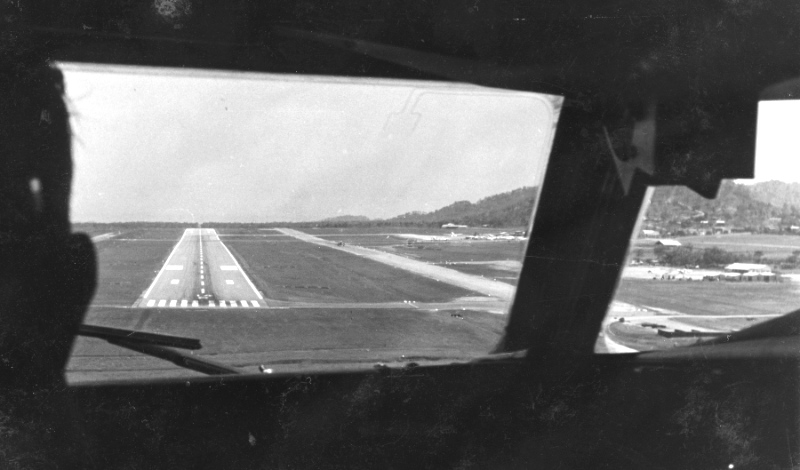
to appreciate the effects of ATC procedures and instructions on pilots. My photo is from the cockpit jump-seat of an Ansett-ANA Boeing 727
on landing approach to Runway 14R at Port Moresby, New Guinea arriving direct from Sydney. Being an aviation enthusiast, I bid mostly for
the older types and enjoyed many cockpit flights and overnight stops with friendy crews of Ansett-ANA Viscounts, Electras and Carvairs.
An additional two weeks on Airlines of NSW F.27 Friendships was to experience outback NSW operations, outside controlled airspace
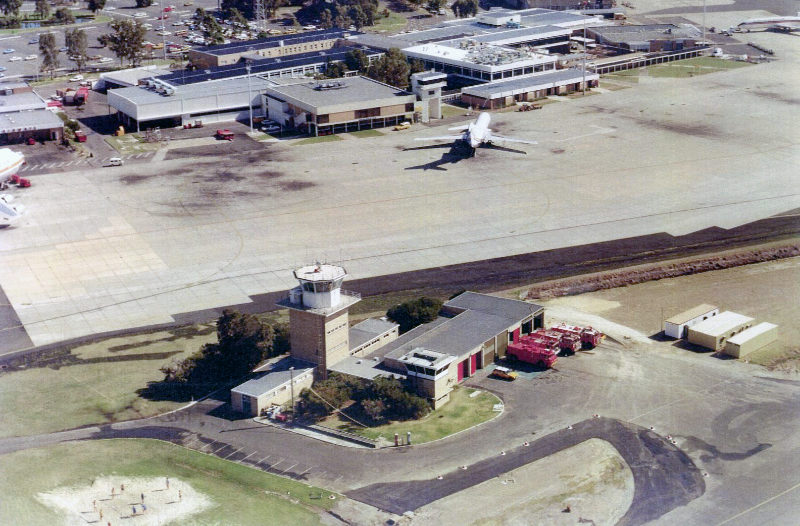
ATC training course in Adelaide in 1969 and was transferred to Perth ATC. Over the next 20 years I worked many shifts in this Tower,
including one-man night shifts, during regular rotations between other Perth ATC positions. Photo: Civil Aviation Historical Society
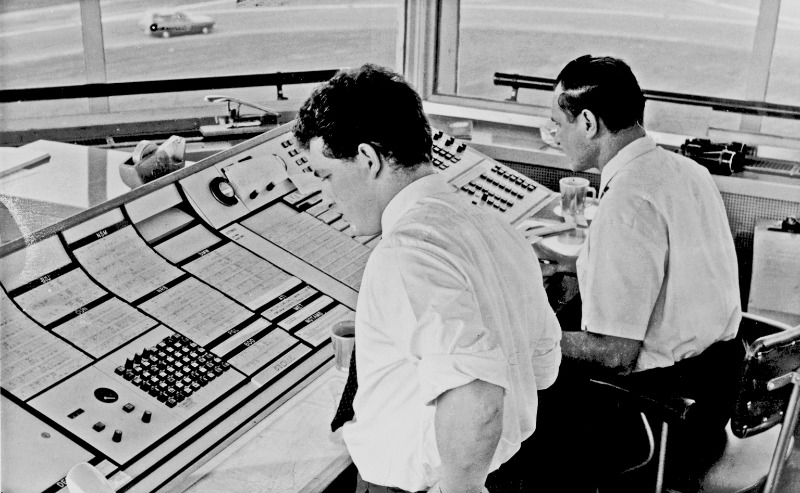
Until the mid 1970s, Perth ATC was Procedural control, Radar assistance requested only for complex sequences or when aircraft would
be delayed. The Tower had three positions, each with their own VHF frequencies:
Left: SMC
(Surface Movement Control & Clearance
Delivery)
Centre: ACC (Area Control - controlled airspace outside 30 miles Perth & Tower Coordinator
Right: APP/ADC (Approach Control & Aerodrome Control & Senior Tower Controller)
I took this photo of Chris Hall on Area Control and Cliff Bolton at right on Approach/Aerodrome Control. Centre: ACC (Area Control - controlled airspace outside 30 miles Perth & Tower Coordinator
Right: APP/ADC (Approach Control & Aerodrome Control & Senior Tower Controller)

microphones which came with the new console. I'm handing over to Dave Richards, the oncoming Evening shift APP/ADC.

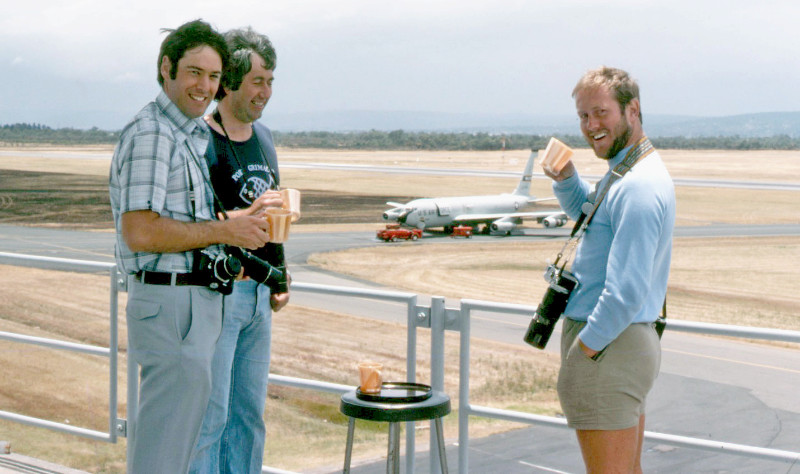
Perth Tower's outside balcony was a perfect spot for aircraft photography.
Here fellow aviation enthusiast friends Mike Austin,
John Chapman and Stuart Bremner enjoy a coffee served in the Tower Coffee Club's finest china.
John Chapman and Stuart Bremner enjoy a coffee served in the Tower Coffee Club's finest china.
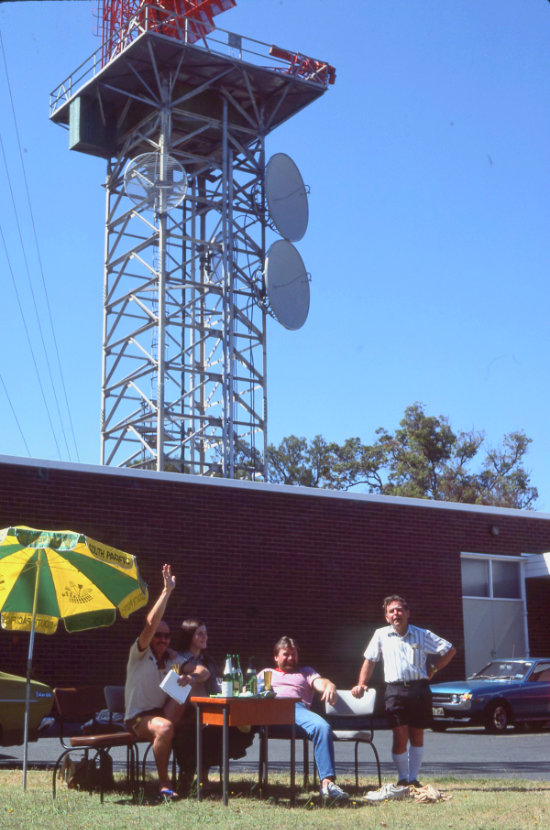
hills east of the city. With no suitable facility at Perth Airport, a short-term solution was to install ATC radar consoles inside the
Kalamunda maintenance building. My photo shows Christmas Day post-shift refreshments on the lawn at Kalamunda: from left
Chris Avenell, Dorena Paganetti, Wayne Troedson and duty radar technician Colin Hayes.
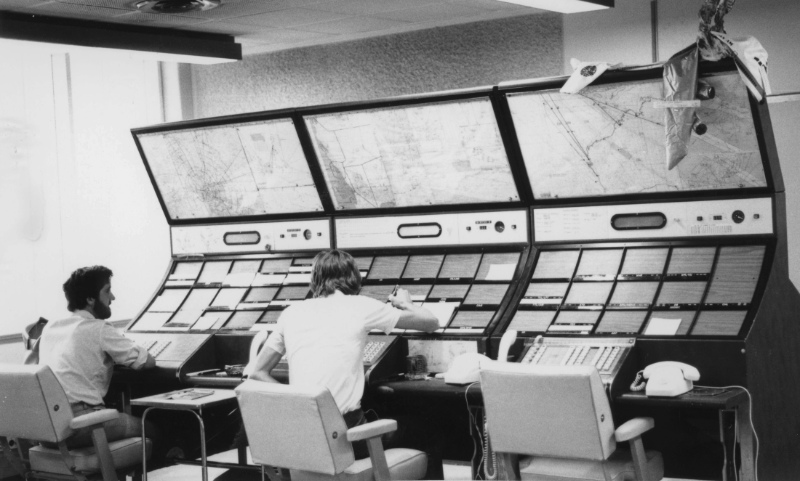
This allowed high level CTA to expand to the north to handle increasing jet traffic between the new iron ore mining towns.
Radar separation (within 150NM Perth) was an intercom call to Kalamunda. Tony Fowler (left) on Perth Arrivals, Lance Harrison on Area.

Jandakot Airport, 10 miles south of Perth Airport is Perth's General Aviation airfield. During the early 1970s Jandakot was Australia's
second busiest airport, behind Bankstown. Perth controllers rotated through Jandakot Tower and my first Perth ratings were there in 1969.
With only two sealed runways, we ran tight circuits with a mix of training and IFR charter flights to Secondary Aerodrome Procedures.
I remember our professional offence at a Head Office instruction which limited us to only 8 aircraft in the circuit.
second busiest airport, behind Bankstown. Perth controllers rotated through Jandakot Tower and my first Perth ratings were there in 1969.
With only two sealed runways, we ran tight circuits with a mix of training and IFR charter flights to Secondary Aerodrome Procedures.
I remember our professional offence at a Head Office instruction which limited us to only 8 aircraft in the circuit.

Jandakot Tower 1977: from left John Bitmead, Frank Trees, Marty Kain and Supervisor ATC Mike Cosgrave.
Aircraft VHF radio transmissions were on console speakers, our telephone-style handsets had Press to Talk buttons to transmit.
Aircraft VHF radio transmissions were on console speakers, our telephone-style handsets had Press to Talk buttons to transmit.
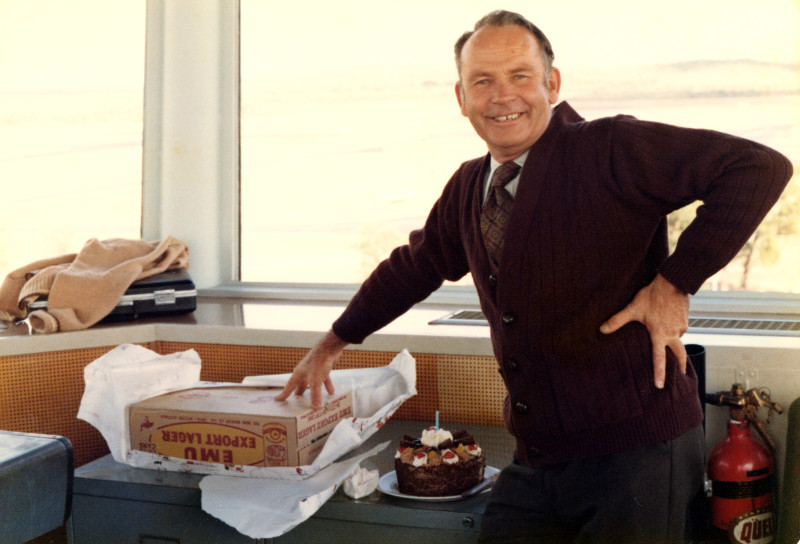
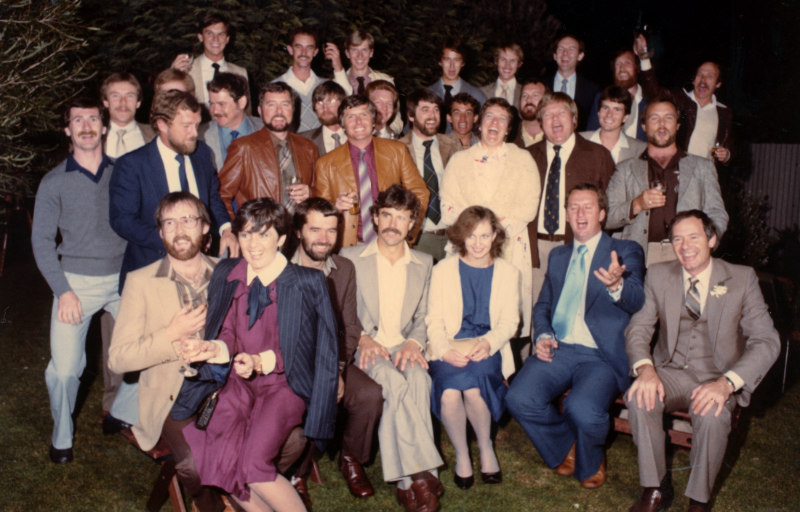
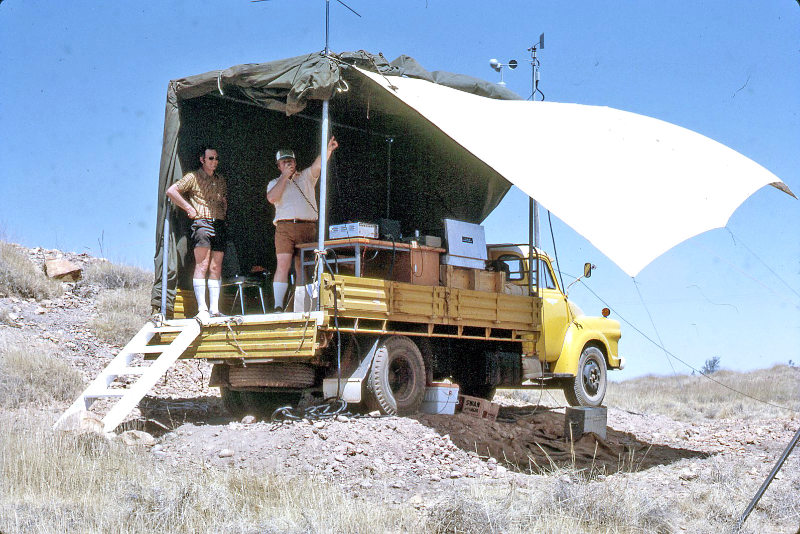
My first Temporary Tower was at Kalgoorlie for the annual Air Trial of 70 aeroplanes. After being flown out in the DCA Bonanza,
I had a basic tower setup on a wooden platform high in the VHF masts.
The above picture at Fitzroy Crossing WA in 1972, a 4 hour flight north from Perth by DCA turboprop Merlin, for a Royal tour.
Norm Kerr and I plus two DCA radio technicians were dropped off to set up on the truck, positioned on a high outcrop on the airfield.
Those were the cringeworthy days when royal aircraft received total Priority and Double Separation Standards.

RAAF support Caribous and charter aircraft bringing press and TV arrived prior to the royal aircraft. Their visit to this remote outback
location was to spend a day with a former Grenadier Guardsman friend, who now managed a nearby Kimberley cattle station.
The HS.748 Captain kindly brought spare meal trays and cold drinks up to our tower, which was very appreciated.
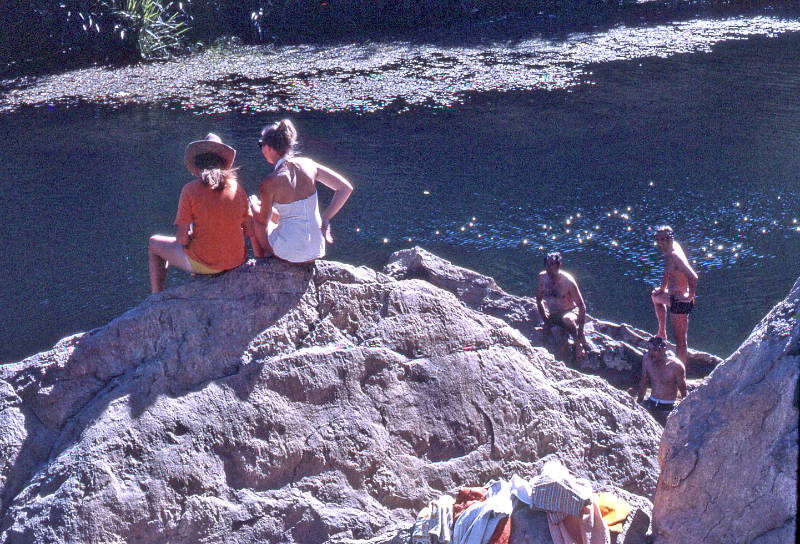
We were left at Fitzroy Crossing four four days to fit with the Merlin's schedule. The two resident school teachers were pleased to
see new faces in town, taking us to their swimming spot where they casually threw rocks at crocodiles while we had a swim.
see new faces in town, taking us to their swimming spot where they casually threw rocks at crocodiles while we had a swim.
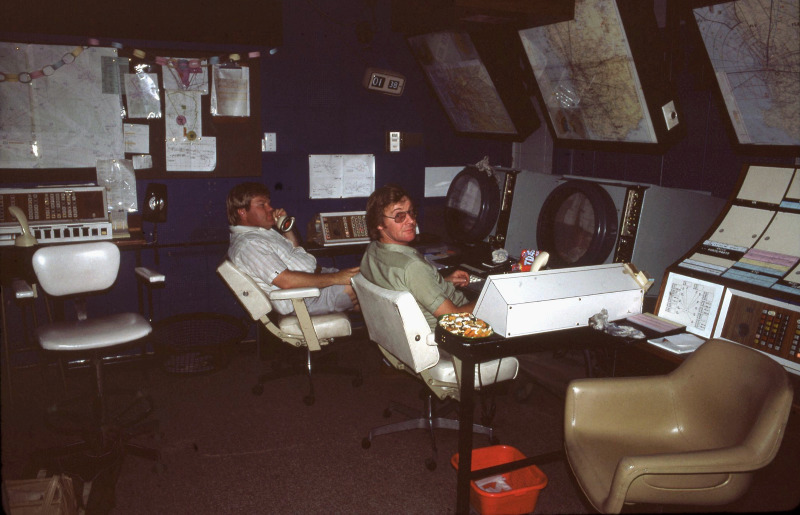
Back
in Perth ATC, 1981 brought the next change when the Area Control
function moved from the airport terminal to Kalamunda Radar,
to form an interim Area Approach Control Centre (AACC). However our radar consoles were Cossor raw displays requiring a dark room,
so the Procedural strip displays and maps were lit by pinpoint lighting. I'm on Approach and Lance Harrison is Arrivals.
Perth Tower now became only an Aerodrome Control function, all controlled airspace owned by Kalamunda.
to form an interim Area Approach Control Centre (AACC). However our radar consoles were Cossor raw displays requiring a dark room,
so the Procedural strip displays and maps were lit by pinpoint lighting. I'm on Approach and Lance Harrison is Arrivals.
Perth Tower now became only an Aerodrome Control function, all controlled airspace owned by Kalamunda.

Brian Willis (SAAC), Peter Roach, GG, Lance Harrison and Chris Avenell having his hair platted by Flight Data Dorena Paganetti.
(Two years later the purpose-built AACC building at Perth Airport was completed and we moved to the luxury of a new spacious centre,
white carpet and bright display ATCARDS radar consoles which allowed bright lighting - we could even see trees through the windows!`)
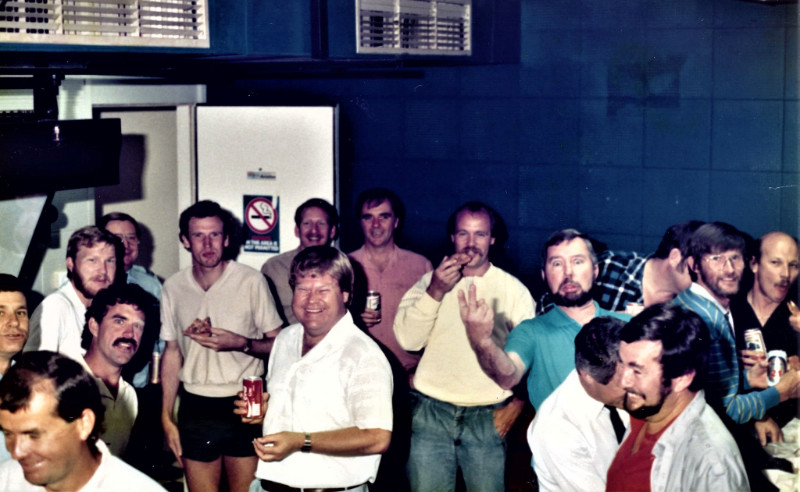
Last drinks and pizza in the cleared-out Kalamunda Radar ATC room with its blue walls. Thanks Jim Blood for the picture .

Perth did not have a night noise curfew, so International and domestic airline flights operated throughout the night.
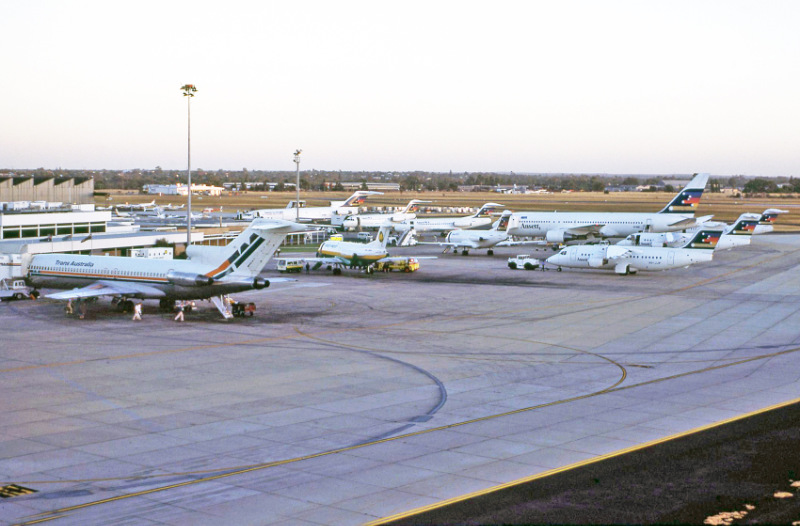
the solo Tower night shift controller would be compiling his handover documents for the oncoming morning shift at 6am.

A new International Terminal had been constructed on the eastern side of the airport - and this new highrise Control Tower.
We moved to the new Perth Tower that year. It was definitely state of the art, but no more aircraft noise and Avtur smell, not so good
when winter ground fogs rolled in and we were "Visual on Top". No more trudging up stairs, there was an fast elevator to the cab.
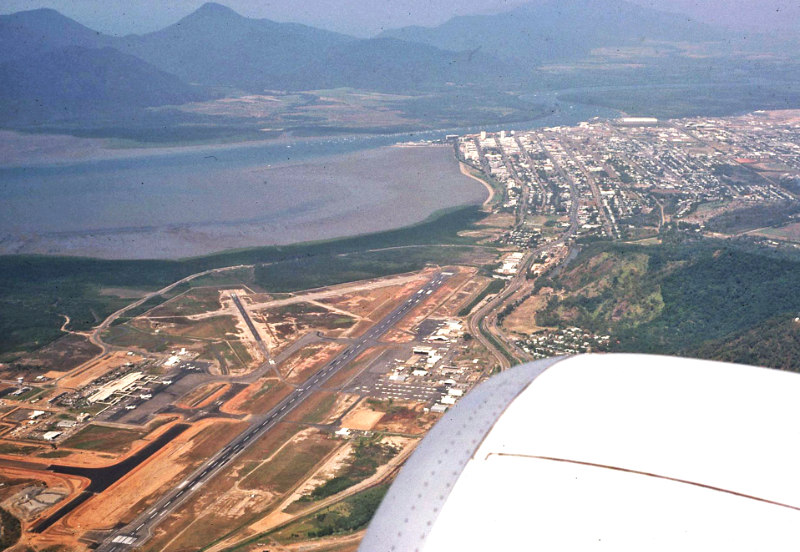
impressive traffic numbers using procedural control without radar. Radar was finally being installed at locations ar

View from the old
Tower on the original Cook Highway side of the Airport. Cairns then had
an eclectic mix of aircraft, International B747s
mixing it with four based DC-3s, Tiger Moth tourist flights, Aero Club training Cessnas and numerous Third Level airline turbine twins.
mixing it with four based DC-3s, Tiger Moth tourist flights, Aero Club training Cessnas and numerous Third Level airline turbine twins.
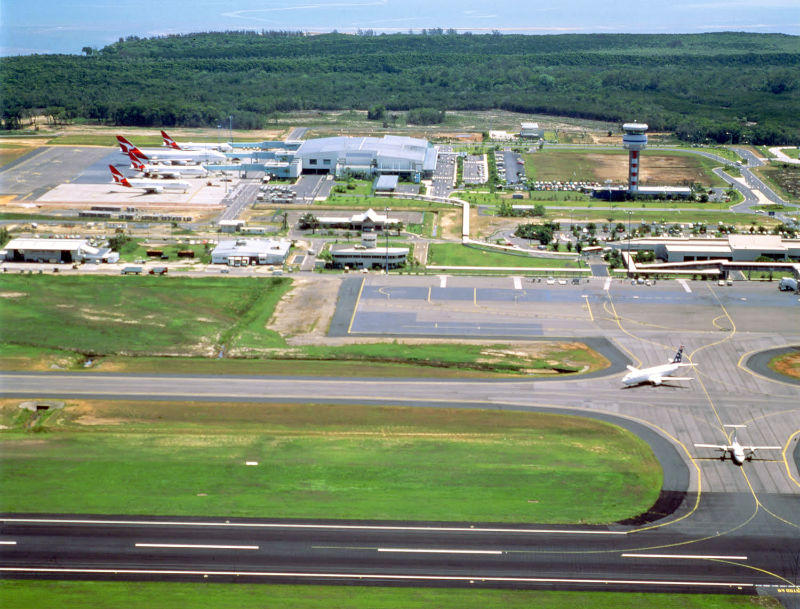
Installation
and testing of the Cairns ATC radars suffered many delays but in 1992
we moved into the new ATC building (top right)
behind the domestic and international terminals on the other side of the airport. Cairns Centre was at the base of the Tower.
Photo: Civil Aviation Historical Society
behind the domestic and international terminals on the other side of the airport. Cairns Centre was at the base of the Tower.
Photo: Civil Aviation Historical Society

(Bevan Bruce) and Arrivals (Tony Sanders), with a nice tropical sunset through the window.
There was also a duty Senior Area Controller who acted as Flow Director to set up the landing sequence for inbound flights.

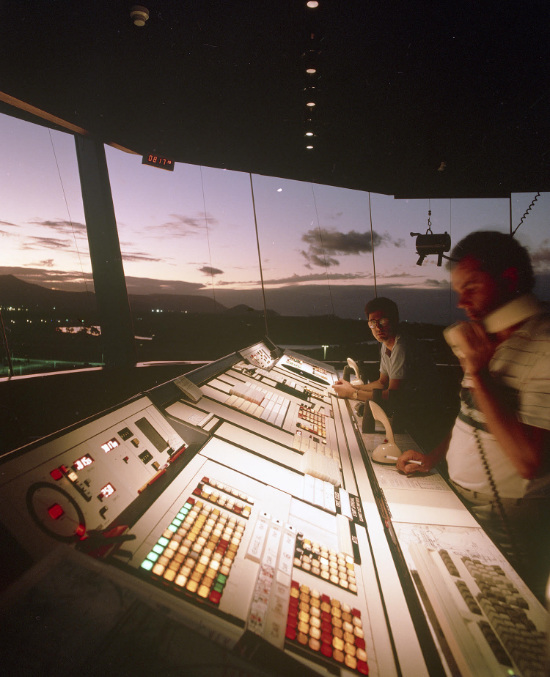
Coordination and aircraft hand-offs between ADC and APP downstairs was by Hotline, call-answer intercom for other units. Selector buttons
control runway, taxiway, approach lighting intensities and monitor servicability of navigation aids (VOR, ILS etc) and VHF radio frequencies.
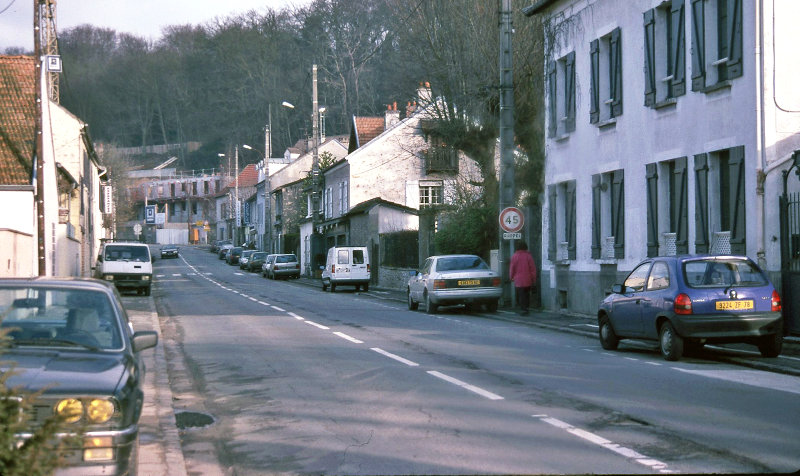
From tropical Cairns to
a freezing Paris in winter 1995. I was with a team of Australian ATCs and technicans sent to the French contractor's
training college at rural Jouy-en-Josas for training on a new ATC system "TAAATS" Eurocat 2000, for which Australia was the launch
customer. This was the main street of the nearby village, whose hotels and restaurants were a well-trodden pathway evening stroll away.
training college at rural Jouy-en-Josas for training on a new ATC system "TAAATS" Eurocat 2000, for which Australia was the launch
customer. This was the main street of the nearby village, whose hotels and restaurants were a well-trodden pathway evening stroll away.

Damien Spain (MEL), Peter Thomas (ADL), Bob Rogers (CNS), Warren Beeston (BNE), Radar Tech Bob (BNE) and our unimpressed waiter.
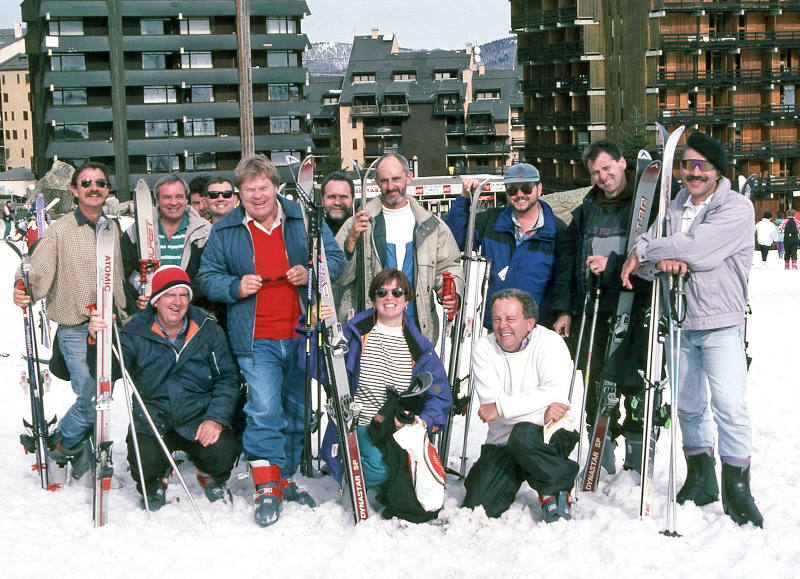
Tolouse happened to be close to French snowfields, where we spent a day before visiting Eurocontrol at Maastricht, Netherlands.
Back in Australia over the following 4 years our team created the TAAATS training program: CBT, classroom and Simulator sessions.

Being Cairns based, I travelled frequently to Melbourne Sydney and Brisbane. Here we demonstrate some features of the new system
to Australian ATC senior manager Bill Pollard. TAAATS brought a huge leap in complexity, but introduced Flight Data Processing and
satellite capability, merging all Australian ATC Centres into just two: Melbourne Centre and Brisbane Centre.
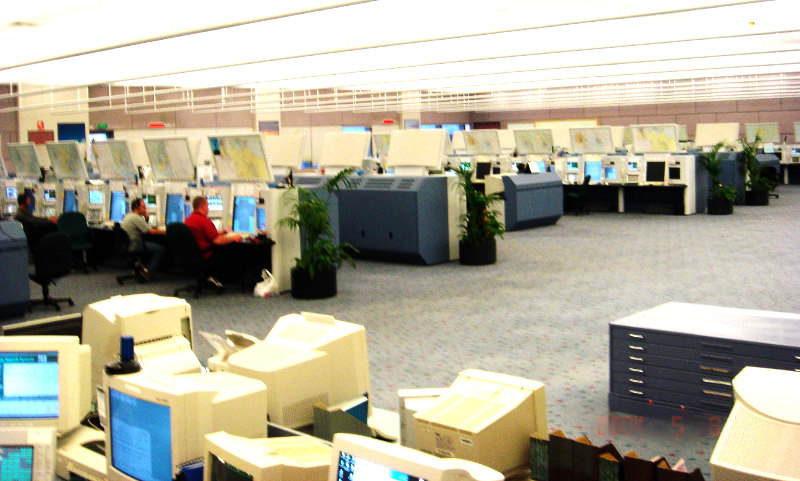
Cairns was the first location to transition to TAAATS. When that was successfully completed, I was transferred to the new Brisbane Centre,
then on to Melbourne Centre just in time to commence its transition bringing in Adelaide and Perth Centres. Dramatic times.

and Antarctic air routes, as well as providing Arrivals sequencing for Melbourne Approach on row 1. Photo by Phil Vabre
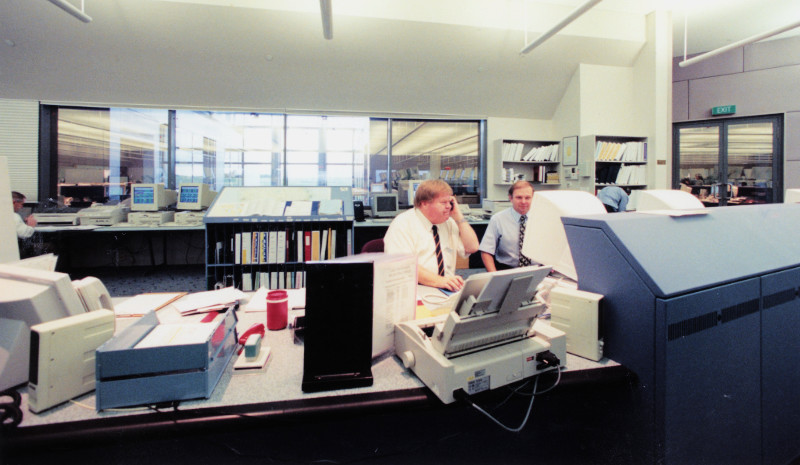
just transferred from Perth, is with me in this picture. OSS set the TAAATS configurations for the room, handled technical faults
and air safety incidents, coordinated operational issues across the new enlarged ML FIR from Indian Ocean to NZ boundary.
A demanding and stimulating position, but my age and far too frequent night shifts were making aviation medicals harder to pass.
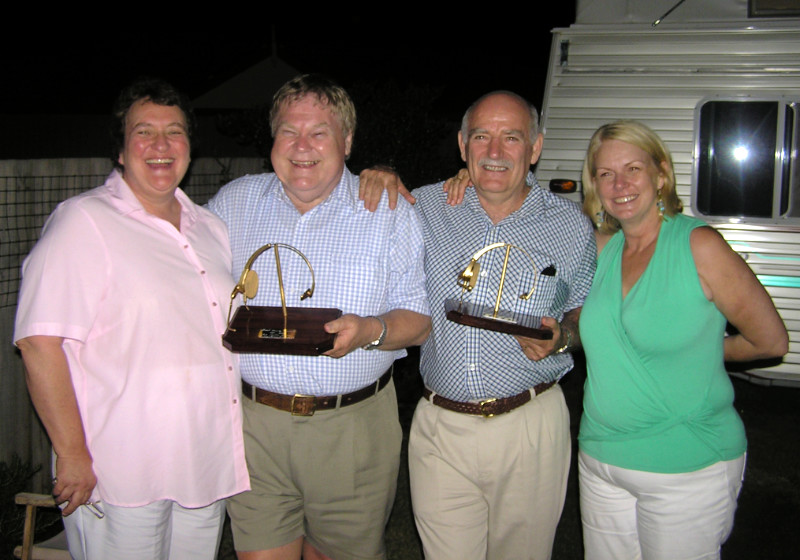
With our wives Jane and Maria, we show off our Golden Headset awards.
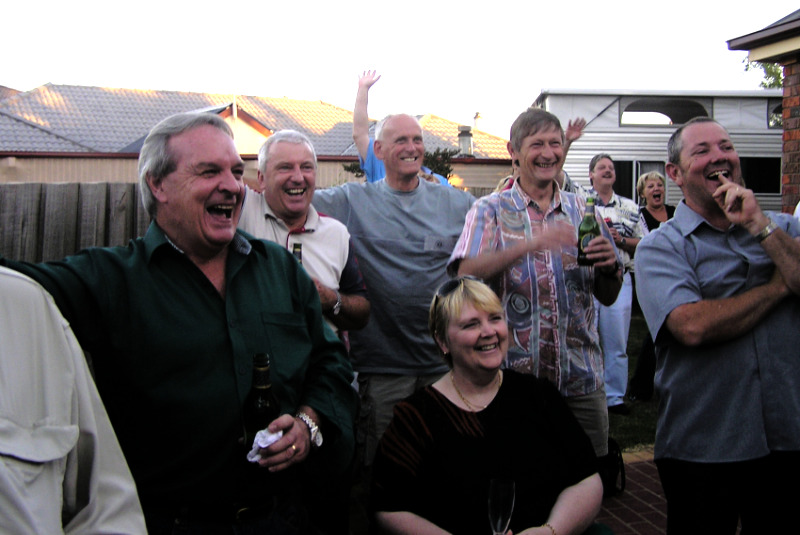
Cairns and Brisbane. This was the reaction to my soulful and sincere farewell speech.
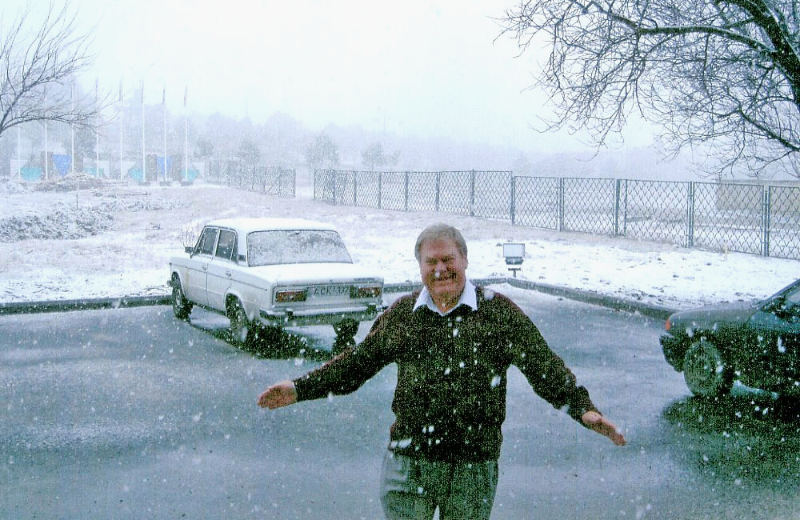
Another change of climate. After retirement, I took a contract as an instructor at an ATC school in Tbilisi, Republic of Georgia. There I joined
Lance Millar and Peter Roach who I had worked with in Cairns ATC. The day of my arrival - they didn't mention the long Georgian winters!
Lance Millar and Peter Roach who I had worked with in Cairns ATC. The day of my arrival - they didn't mention the long Georgian winters!
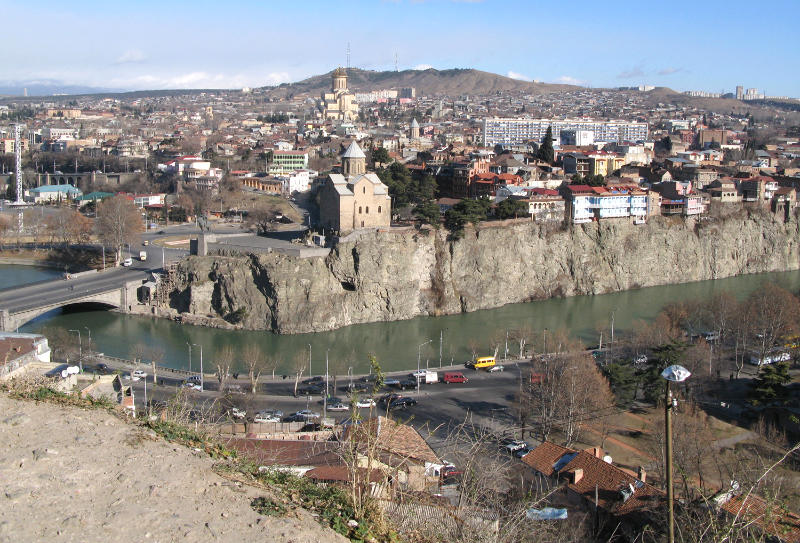
Georgia had been a member of the Soviet Union until 1992 and was still struggling to establish stable basic infrastructure such as
electricity, gas and water supply. Despite churches and buildings going back to the 12th Century and Caucasus Mountain scenery,
tourism was largely unknown. For us sheltered Aussies, there was a culture shock and unexpected surprise around every corner.
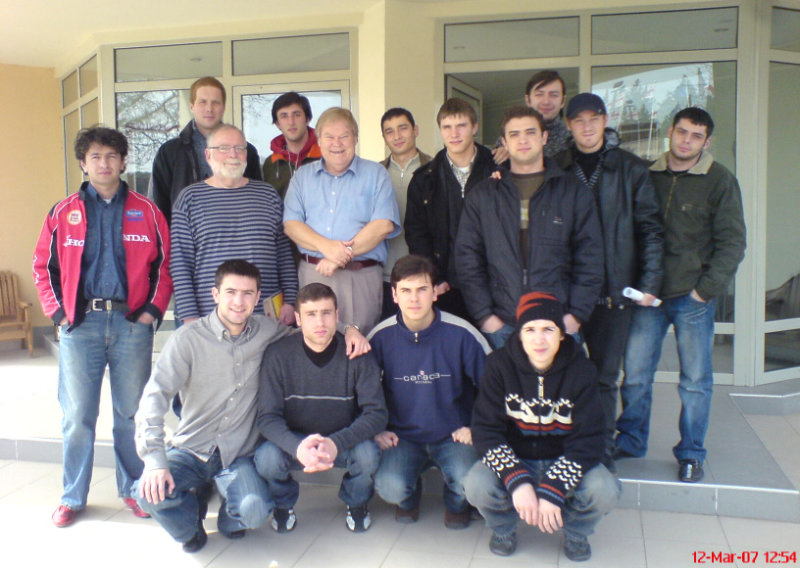
Ulf from Sweden who came to us via via Botswana and Armenia. Other instructors came from Canada, Malaysia, Kazakhstan and Britain.
Our ATC Simulator could be configured as Tbilisi Centre, Approach/Departures and for Tower training.
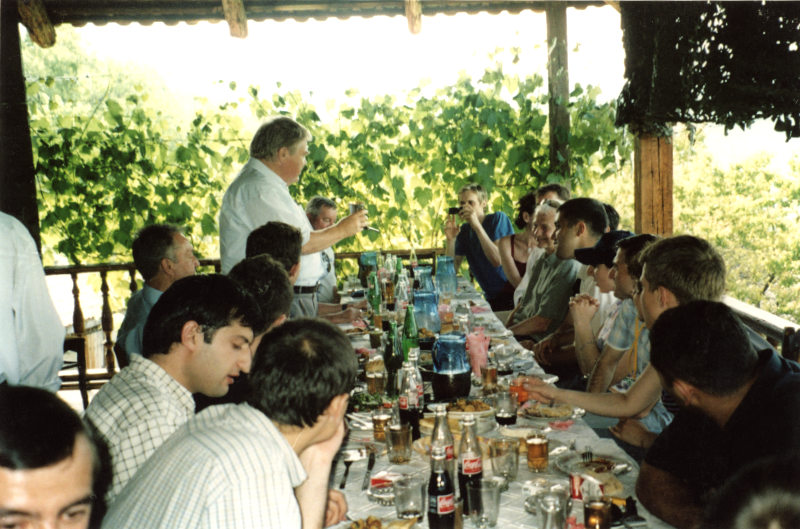
lunch event was held usually in rustic open air venues at long tables laden with traditional food, the Georgian red wine flowing to the
numerous speeches and toasts. Here I am toasting a course and wishing them long international ATC careers.
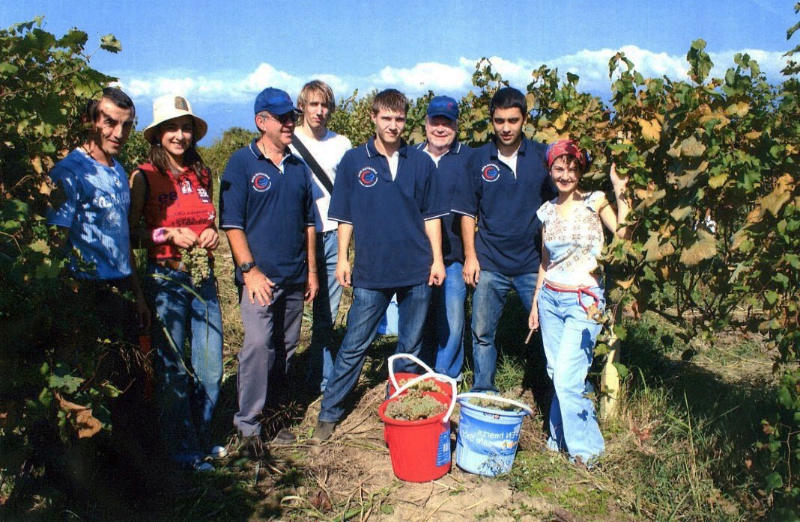
Wine
was a major part of the Georgian economy. One day the President
declared that year's grape harvest was under threat and all
Georgians were expected to help the following day. Airport workers were sent by bus into the countryside to spend the day in vineyards.
This was part of our college team, with our Principal Lance Millar third from the left.
Georgians were expected to help the following day. Airport workers were sent by bus into the countryside to spend the day in vineyards.
This was part of our college team, with our Principal Lance Millar third from the left.
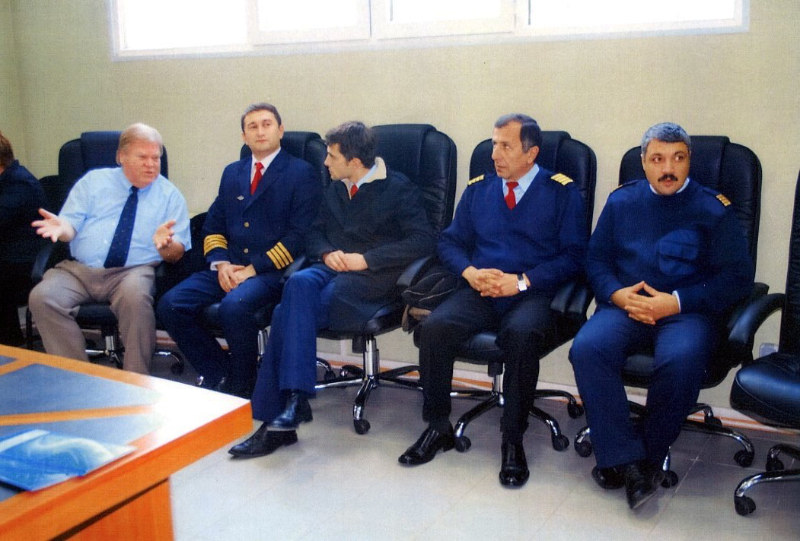
airline Air Zena, who flew Yak 42s and Boeing 737s. The younger First Officers were proficient in English, but the senior Captains from
long Aeroflot careers, had not needed Engish untiI the new ICAO rules. Sadly we could not pass several senior men, amid much emotion.
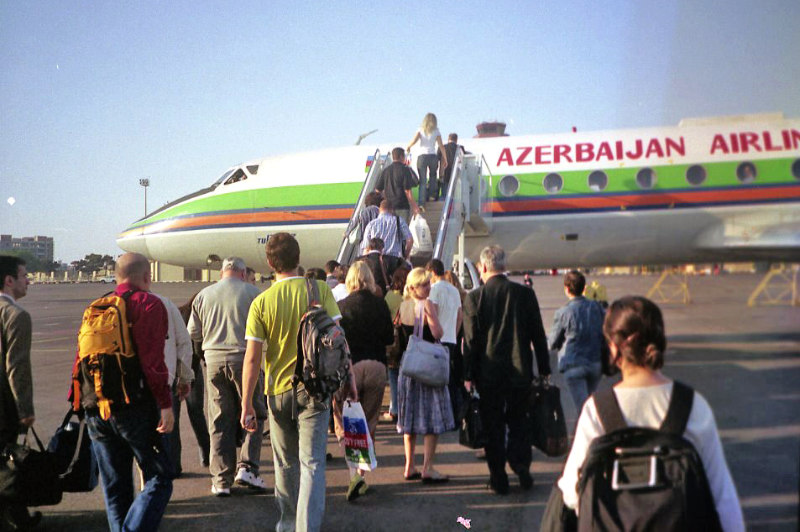
Weekend
visits to neighbouring countries was a bonus while in Tbilisi. I
took this photo as a group of us left TBS for a visit to Baku,
Azerbaijan. The Tupolev Tu-134 was open seating and overbooked, so we joined the mad scramble to board.
(After returning home from Tbilisi, I took a Melbourne ATC Centre contract with the Flex Tracks Project, creating different daily air routes
between Middle East and Australian airports utilising accurate MET forecast upper winds and jetstreams. Flex Tracks could save an airliner
up to a ton of fuel each flight. Emirates Airlines was a project partner and us Australian "Trackmasters" spent time at their Dubai Ops Centre.
It was a shock to be expected to go to work in Dubai straight off a 14 hour flight from Melbourne, but Flex Tracks was a great experience.
Following other part-time contracts testing new ATC software, in 2013 I decided the time had come to retire for good.)
Azerbaijan. The Tupolev Tu-134 was open seating and overbooked, so we joined the mad scramble to board.
(After returning home from Tbilisi, I took a Melbourne ATC Centre contract with the Flex Tracks Project, creating different daily air routes
between Middle East and Australian airports utilising accurate MET forecast upper winds and jetstreams. Flex Tracks could save an airliner
up to a ton of fuel each flight. Emirates Airlines was a project partner and us Australian "Trackmasters" spent time at their Dubai Ops Centre.
It was a shock to be expected to go to work in Dubai straight off a 14 hour flight from Melbourne, but Flex Tracks was a great experience.
Following other part-time contracts testing new ATC software, in 2013 I decided the time had come to retire for good.)

We agreed it had been an enjoyable and fulfilling profession, but the constant shift work and 2am pizza deliveries had taken their toll.
Crossing paths over the years, in person or recognising voices on intercoms, maintained our familiarity and group spirit.